“If There Is Energy Within The Substance It Can Only Come From Without. This Truth Was So Manifest

“If there is energy within the substance it can only come from without. This truth was so manifest to me that I expressed it in the following axiom: ‘There is no energy in matter except that absorbed from the medium…’ If all energy is supplied to matter from without then this all important function must be performed by the medium.”
“When radio-active rays were discovered their investigators believed them to be due to liberation of atomic energy in the form of waves. This being impossible in the light of the preceding I concluded that they were produced by some external disturbance and composed of electrified particles. My theory was not seriously taken although it appeared simple and plausible. Suppose that bullets are fired against a wall. Where a missile strikes the material is crushed and spatters in all directions radial from the place of impact. In this example it is perfectly clear that the energy of the flying pieces can only be derived from that of the bullets. But in manifestation of radio-activity no such proof could be advanced and it was, therefore, of the first importance to demonstrate experimentally the existence of this miraculous disturbance in the medium. I was rewarded in these efforts with quick success largely because of the efficient method I adopted which consisted in deriving from a great mass of air, ionized by the disturbance, a current, storing its energy in a condenser and discharging the same through an indicating device. This plan did away with the limitations and incertitude of the electroscope first employed and was described by me in articles and patents from 1900 to 1905. It was logical to expect, judging from the behavior of known radiations, that the chief source of the new rays would be the sun, but this supposition was contradicted by observations and theoretical considerations which disclosed some surprising facts in this connection.
“Light and heat rays are absorbed in their passage through a medium in a certain proportion to its density. The ether, although the most tenuous of all substances, is no exception to this rule. Its density has been first estimated by Lord Kelvin and conformably to his finding a column of one square centimeter cross section and of a length such that light, traveling at a rate of three hundred thousands kilometers per second, would require one year to traverse it, should weigh 4.8 grams. This is just about the weight of a prism of ordinary glass of the same cross section and two centimeters length which, therefore, may be assumed as the equivalent of the ether column in absorption. A column of the ether one thousand times longer would thus absorb as much light as twenty meters of glass. However, there are suns at distances of many thousands of light years and it is evident that virtually no light from them can reach the earth. But if these suns emit rays immensely more penetrative than those of light they will be slightly dimmed and so the aggregate amount of radiations pouring upon the earth from all sides will be overwhelmingly greater than that supplied to it by our luminary. If light and heat rays would be as penetrative as the cosmic, so fierce would be the perpetual glare and so scorching the heat that life on this and other planets could not exist.
“Rays in every respect similar to the cosmic are produced by my vacuum tubes when operated at pressures of ten millions of volts or more, but even if it were not confirmed by experiment, the theory I advanced in 1897 would afford the simplest and most probable explanation of the phenomena. Is not the universe with its infinite and impenetrable boundary a perfect vacuum tube of dimensions and power inconceivable? Are not its fiery suns electrodes at temperatures far beyond any we can apply in the puny and crude contrivances of our making? Is it not a fact that the suns and stars are under immense electrical pressures transcending any that man can ever produce and is this not equally true of the vacuum in celestial space? Finally, can there be any doubt that cosmic dust and meteoric matter present an infinitude of targets acting as reflectors and transformers of energy? If under ideal working conditions, and with apparatus on a scale beyond the grasp of the human mind, rays of surpassing intensity and penetrative power would not be generated, then, indeed, nature has made an unique exception to its laws.
"It has been suggested that the cosmic rays are electrons or that they are the result of creation of new matter in the interstellar deserts. These views are too fantastic to be even for a moment seriously considered. They are natural outcroppings of this age of deep but unrational thinking, of impossible theories, the latest of which might, perhaps, deal with the curvature of time. What this world of ours would be if time were curved…“
–Nikola Tesla
“The Eternal Source of Energy of the Universe, Origin and Intensity of Cosmic Rays.” October 13, 1932.
More Posts from Engineeringtrivia-blog and Others

charles babbage: father of the computer (1970)


F1 is more than just racing, it is an engineering battle. In this gif you can see the absolute control of wing tip vortices generated from the front wing. This is just an example to show the extreme aerodynamics that these vehicles are engineered for.
Have a great day!
* What are wing tip vortices ?
** Smoke angels and wing tip vortices
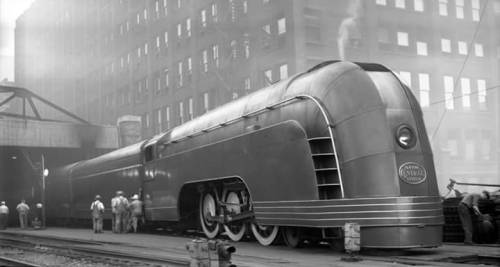
One of New York Central’s “Mercury” engines in Chicago, 1936.

Poor Alex :(. If you don’t get it, you can’t be an engineer 😂.
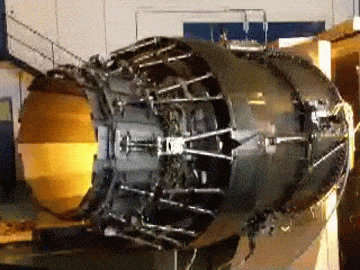
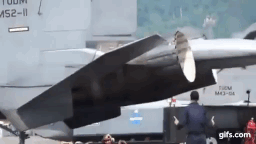
When you are in the combat zone, agility of a fighter jet is of utmost importance. But as an engineer, if you have already fiddled around with the wing structure your next option would be to fiddle around with the direction of the thrust.
Thrust Vectoring
Thrust vectoring is primarily used for directional control in rockets and jets. And one achieves this by manipulating the direction of thrust .

This generates the necessary moments (and forces) that enable the directional control of the aircraft.

An aircraft traditionally has three “degrees of freedom” in aerodynamic maneuverability; pitch, yaw and roll. **
The number of “dimensions” of thrust vectoring relates directly to how many degrees of freedom can be manipulated using only the vectored engine thrust.
Therefore, 2D vectoring allows control over two degrees of freedom (typically pitch plus either roll or yaw) while 3D controls all three.
Lockheed Martin F35B
The F-35B short takeoff/vertical landing (STOVL) variant is the world’s first supersonic STOVL stealth aircraft.

It achieves STOVL by swiveling its engine 90 degrees and directing its thrust downward during take off/lvertical landing mode.

In the following gif you can witness the transition from a 90 degree tilted engine towards a forward thrust engine during flying.
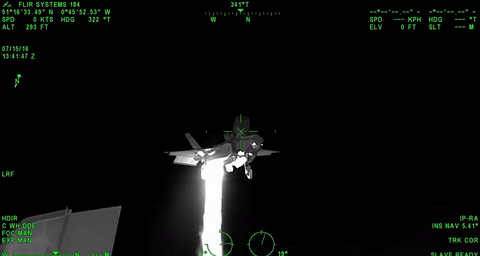
Unlike other variants of the Lockheed Martin F-35 the F-35B has no landing hook. And as a result, witnessing its landing is rather pretty special.

But nevertheless, this is one of those posts which addresses a topic that has been a gold mine for research. If this sort of thing fascinated you, there have been a lot of research conducted by NASA do check them out.
Have a great day!
*Rockets - How to turn during flight ?
** Aviation 101 : Pitch Roll and Yaw
Back to School Resources
Need help with your science homework? We’ve got you covered! Here are some out-of-this world (pun intended) resources for your science and space questions.
Let’s take a look…
NASA Space Place

From questions like “Why does Saturn have rings?” to games that allow you to explore different galaxies, NASA Space Place has a variety of content for elementary-age kids, parents and anyone who likes science and technology topics.
Visit the NASA Space Place website or follow @NASASpacePlace on Twitter.
SciJinks

Targeting middle-school students and teachers, this NOAA and NASA partnership has games and useful information about weather and other Earth science subjects.
Visit the SciJinks website or follow @SciJinks on Twitter.
NASA Education

The NASA Education website includes an A-Z list of education opportunities that we offer throughout the year, as well as education programs, events and resources for both students and educators.
We have a diverse set of resources for multiple age groups:
Grades K-4
Grades 5-8
Grades 9-12
Higher Education
Informal Education
Visit the NASA Education website or follow @NASAedu on Twitter.
Want to get NASA Education materials for your classroom? Click HERE.
A Year of Education on the International Space Station

Although on different crews, astronauts Joe Acaba and Ricky Arnold - both former teachers - will work aboard the International Space Station. K-12 and higher education students and educators can do NASA STEM activities related to the station and its role in our journey to Mars. Click HERE for more.
Sally Ride EarthKAM

Also on the International Space Station, the Sally Ride EarthKAM @ Space Camp allows students to program a digital camera on board the space station to photograph a variety of geographical targets for study in the classroom.
Registration is now open until Sept. 25 for the Sept. 26-30 mission. Click HERE for more.
NASA eClips™

NASA eClips™ are short, relevant educational video segments. These videos inspire and engage students, helping them see real world connections by exploring current applications of science, technology, engineering and mathematics, or STEM, topics. The programs are produced for targeted audiences: K-5, 6-8, 9-12 and the general public.
Space Operations Learning Center

The Space Operations Learning Center teaches school-aged students the basic concepts of space operations using the web to present this educational content in a fun and engaging way for all grade levels. With fourteen modules, there’s lots to explore for all ages.
The Mars Fun Zone

The Mars Fun Zone is a compilation of Red Planet-related materials that engage the explorer inside every kid through activities, games, and educational moments.
Fly Away with NASA Aeronautics

Frequent flyer or getting ready to earn your first set of wings? From children’s books for story time to interactive flight games, we’ve got Aeronautics activities for students of all ages that are sure to inspire future scientists, mathematicians and engineers.
On Pinterest? We have a board that highlights NASA science, technology, engineering and math (STEM) lessons, activities, tools and resources for teachers, educators and parents.
Check it out here: https://www.pinterest.com/nasa/nasa-for-educators/
Make sure to follow us on Tumblr for your regular dose of space: http://nasa.tumblr.com.










Smithsonian’s National Air & Space Museum Udvar-Hazy Center in Chantilly, Virginia, offers the unique sight of a complete Mercury spacecraft. Many of these spacecraft are available for viewing all over the United States, but this one is special because it did not fly.
During the course of a Mercury flight, several parts of the spacecraft are jettisoned and not recovered, including the retro package. This piece of equipment is visible here in my photos as the striped metal object strapped to the bottom of the heat shield. This small cluster of solid rocket motors was responsible for the safe return of the astronaut from space, making just enough thrust to change the shape of the orbit so that it would meet the atmosphere and use aerobraking for a ballistic reentry.
If this package had not fired properly, the astronaut would be faced with the dire situation of being stuck in orbit. Fortunately, this never happened in real life, but it was captured in the fanciful novel “Marooned” by Martin Cardin, in which a NASA astronaut was stranded on orbit after his retro rockets failed. When the book was released in 1964, it was so influential that it actually changed procedures for Mercury’s follow on program Project Gemini, adding more redundancy to the spacecraft’s reentry flight profile.
Alan Shepard, the first American in space and later Apollo 14 moonwalker, didn’t fail to notice that there was a leftover spacecraft at the end of the Mercury program. He lobbied for a second Mercury flight in this ship, speaking personally to both NASA Administrator James Webb and President John Kennedy about this flight. He told them his idea of an “open ended” mission in which they would keep him in orbit indefinitely until there was a malfunction or consumables began to run out. Webb stated (and Kennedy agreed) that it was more important to shelve the Mercury spacecraft in order to jump start the more capable Gemini Program. Thus, we now have this whole Mercury on display for future generations to appreciate.
Why is Glass Transparent?
We are now in ‘The Glass Age’. It is impossible to imagine a world without glass. From Mobile phones to glass panels, it is omnipresent.
Such a pivotal role does Glass play in our day to day to lives, but yet when confronted with the question - “why is glass transparent?”, we are speechless! But hey! This post is dedicated to answering that burning question.
How do we see things ?
Lights travels in straight lines. When light hits an object, it bounces off other objects (reflects) and enters our eyes. And this information is processed by our brain and this is how we see the object.

An atomic interlude.
You may know that an Atom consists of a nucleus with electrons orbiting around it. These electrons are confined to a trajectory known as an Orbit. And there exists a gap between two subsequent orbits where no electron can exist. Known as an energy-gap or a band gap( Band gap ).
And for an electron to jump from one orbit to another:
It must gain energy and jump to a higher level. ( Away from the nucleus )
It must lose energy and jump to a lower level. ( Closer to the nucleus)
The energy to make such transitions is provided by light.

What decides whether an object is Transparent, Translucent or opaque?
Imagine you are now a photon. And you are in a collision course with a material.There are three possible outcomes:

The substance absorbs the photon. This occurs when the photon gives up its energy to an electron located in the material. Armed with this extra energy, the electron is able to move to a higher energy level, while the photon disappears.
The substance reflects the photon. To do this, the photon gives up its energy to the material, but a photon of identical energy is emitted.
The substance allows the photon to pass through unchanged. Known as transmission, this happens because the photon doesn’t interact with any electron and continues its journey until it interacts with another object.
Glass, of course, falls into this last category. Photons pass through the material because they don’t have sufficient energy to excite a glass electron to a higher energy level. And due to this, we are able to see through glass!

If the material absorbs the photon, it is said to be opaque. And if it allows some photon to pass through and others get absorbed, the material is termed Translucent.
Smart Glass.
Glass does not necessarily have to transparent/ translucent/ opaque all the time.
Smart glass is glass whose light transmission properties are altered when voltage, light or heat is applied. Generally, the glass changes from translucent to transparent, changing from blocking some (or all) wavelengths of light to letting light pass through.



Pumping air through a bed of sand can make the grains behave just like a liquid. This process is called fluidization. Air introduced at the bottom of the bed forces its way upward through the sand grains. With a high flow rate, the space between sand grains gets larger, eventually reaching a point where the aerodynamic forces on a grain of sand equal gravitational forces. At this point the sand grains are essentially suspended in the air flow and behave like a fluid themselves. Light, buoyant objects – like the red ball above – can float in the fluidized sand; heavier, denser objects will sink. Fluidization has many useful properties – like good mixing and large surface contact between solid and fluid phases – that make it popular in industrial applications. For a similar (but potentially less playful) process, check out soil liquefaction. (Image credits: R. Cheng, source; via Gizmodo; submitted by Justin)
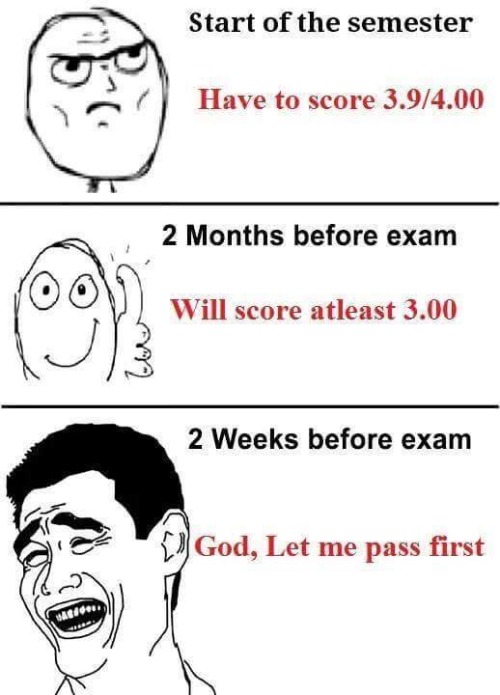
The three stages before an exam. 😂
-
 brandenglenn liked this · 2 years ago
brandenglenn liked this · 2 years ago -
 tmblraku reblogged this · 2 years ago
tmblraku reblogged this · 2 years ago -
 geovannyv83 liked this · 4 years ago
geovannyv83 liked this · 4 years ago -
 epistemelogia liked this · 4 years ago
epistemelogia liked this · 4 years ago -
 monmonshi liked this · 4 years ago
monmonshi liked this · 4 years ago -
 dumbkool reblogged this · 4 years ago
dumbkool reblogged this · 4 years ago -
 riderinzestorm liked this · 4 years ago
riderinzestorm liked this · 4 years ago -
 70thdimension liked this · 4 years ago
70thdimension liked this · 4 years ago -
 monsterhole liked this · 4 years ago
monsterhole liked this · 4 years ago -
 pinkflufflyunicors liked this · 4 years ago
pinkflufflyunicors liked this · 4 years ago -
 marsstudiesformed reblogged this · 4 years ago
marsstudiesformed reblogged this · 4 years ago